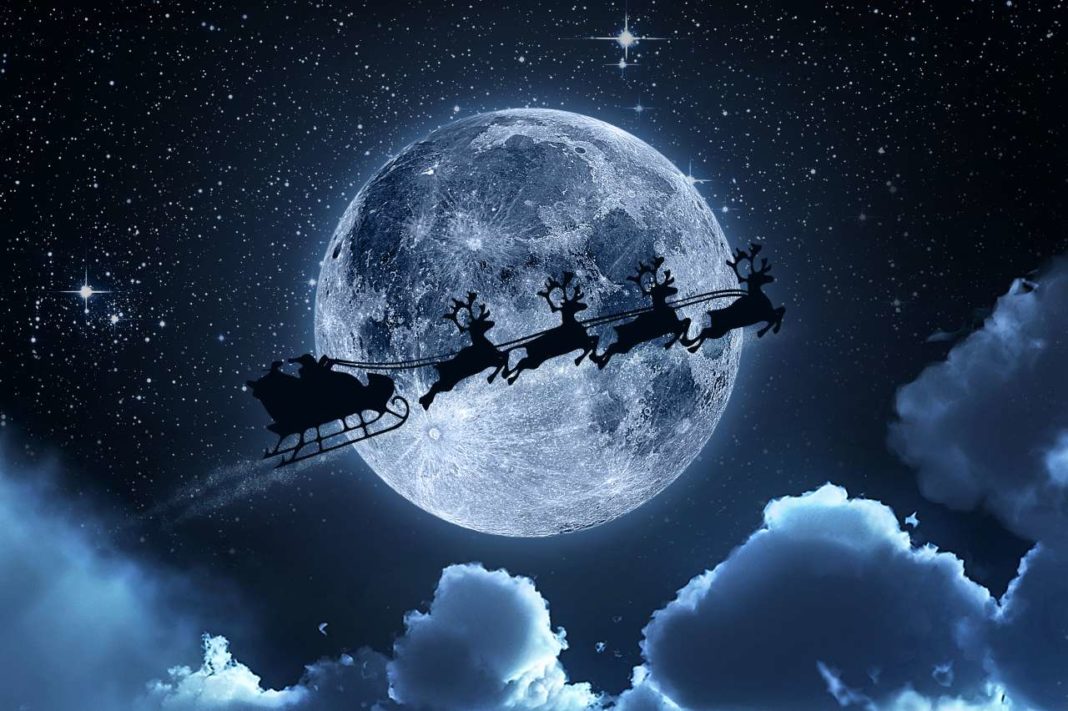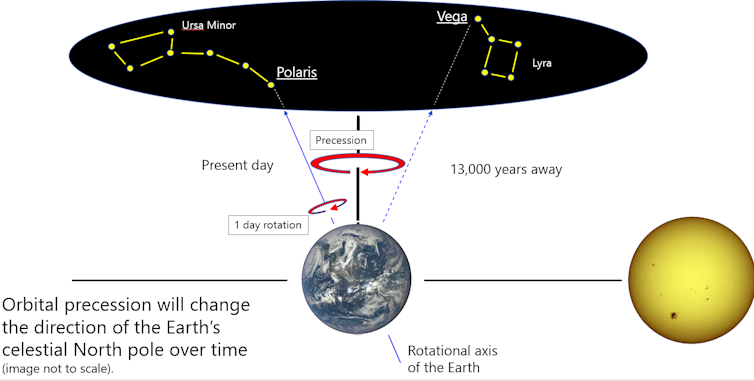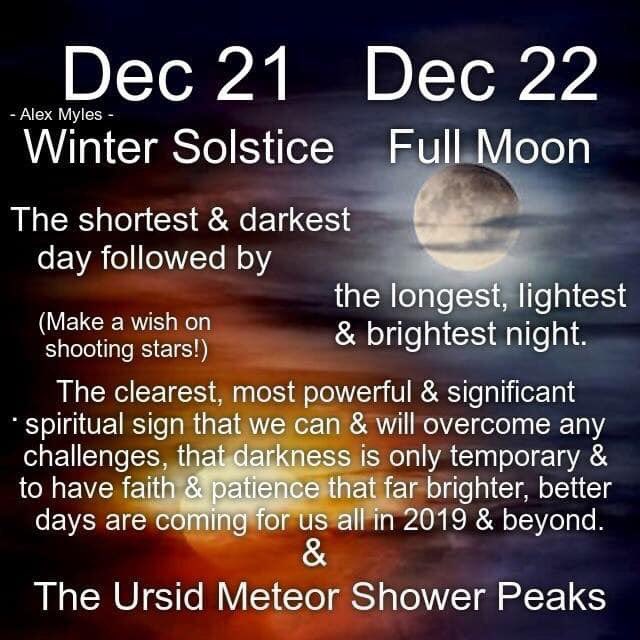LET US DREAM A TRANSFORMED FUTURE during this year’s rare combination of Winter Solstice and Full Moon, December 21-22, 2018
Posted on December 19, 2018 by Ann Kreilkamp

Approximately every 19 years, the Winter Solstice coincides with that year’s final Full Moon (called “Cold Moon”). And since the Winter Solstice is set for the moment the Sun reaches 0°00 Capricorn, therefore, Full Moon on Winter Solstice will always occur at 0°00 Cancer, opposite the 0°00 Capricorn Sun. While these two events are not exactly aligned — some 18 hours separates their exact positions — the coincidence is close enough to deem this Winter Solstice/Full Moon every bit as special as any of the 19-year returns of this doubly significant event.
The connection between the two is also interesting because, although Winter Solstice signifies the longest dark night of the year, the Full Moon on that date brightens the dark. Darkness and Light, together! A wonderful symbol for how we are, each of us, a combination of darkness and light: the dark part of ourselves we don’t know very well (also called the unconscious “shadow”) and so therefore tend to either deny, ignore, or project onto others, and the light part of ourselves that we do know and identify with (the conscious persona).
Likewise on a collective level, Darkness and Light. Nations tend to see themselves and their allies as “good” and others, their “enemies,” as “evil. Hard to believe: our penchant for war, how we’ve been “goin’ at it” for thousands of years, despite that, as Sun Tzu put it, “no nation has ever benefitted from prolonged war.”
From the vantage point of where I sit, visiting family in Boston, this unusual Winter Solstice itself occurs at 5:23 PM EST on December 21, 2018.

Likewise, from this same vantage point of Boston, The Solstice Full Moon (and the final full moon of the year), occurs at 11:28 AM EST on December 22, 2018.

I invite us to view the time period between these two events — from the evening of the 21st through early afternoon of the 22nd, as an opening space. A space that allows for dreaming, visions, a hushed observance of dark/light magnificence, as we internally sense the New Beginning of this next solar year which, every 19 years, brings with it the possibility — and, I would say, the stark necessity — of dynamic balance: between Outer Capricorn and Inner Cancer, between objective structures of society and subjective security of family, between overall planning and intimate communion. Both are of intrinsic value; for if we focus only on the Outer, then the Inner suffers. And vice versa.
The 0° of any cardinal sign, and Capricorn and Cancer are both cardinal signs, signify the resonance of this hushed observance to the Aries point, 0° Aries, cardinal sign of brand new beginnings, at every level.
Check again the two charts above. Notice Mercury and Jupiter, exactly conjunct at 9-10° Sagittarius, sign of philosophy, wisdom, ethics, large perspectives. Curious Mercury notices, names, communicates and shares; and generous Jupiter, ruler of Sagittarius, expands and magnifies whatever it touches. May this sacred Solstice Moment shift humanity into a brand new beginning. May we utilize this spacious present between the evening of the 21st and early afternoon of the 22nd to re-boot the human hard drive. Yes, let us choose peace, prosperity and abundance, in cooperation with each other, Mother Nature, and her cosmic home.
Let’s shoot for that.
Shoot for the stars.
BTW: Several very recent political events in the U.S. feel, to me, prescient, and very much in line with the Mercury/Jupiter Sagittarius conjunction at the upcoming Winter Solstice Full Moon: 1) the successful bi-partisan bill for prison reform, and 2) Trump’s announcement that he is going to bring all the troops home from Syria.
Thanks to: https://www.exopermaculture.com
Posted on December 19, 2018 by Ann Kreilkamp

Approximately every 19 years, the Winter Solstice coincides with that year’s final Full Moon (called “Cold Moon”). And since the Winter Solstice is set for the moment the Sun reaches 0°00 Capricorn, therefore, Full Moon on Winter Solstice will always occur at 0°00 Cancer, opposite the 0°00 Capricorn Sun. While these two events are not exactly aligned — some 18 hours separates their exact positions — the coincidence is close enough to deem this Winter Solstice/Full Moon every bit as special as any of the 19-year returns of this doubly significant event.
The connection between the two is also interesting because, although Winter Solstice signifies the longest dark night of the year, the Full Moon on that date brightens the dark. Darkness and Light, together! A wonderful symbol for how we are, each of us, a combination of darkness and light: the dark part of ourselves we don’t know very well (also called the unconscious “shadow”) and so therefore tend to either deny, ignore, or project onto others, and the light part of ourselves that we do know and identify with (the conscious persona).
Likewise on a collective level, Darkness and Light. Nations tend to see themselves and their allies as “good” and others, their “enemies,” as “evil. Hard to believe: our penchant for war, how we’ve been “goin’ at it” for thousands of years, despite that, as Sun Tzu put it, “no nation has ever benefitted from prolonged war.”
From the vantage point of where I sit, visiting family in Boston, this unusual Winter Solstice itself occurs at 5:23 PM EST on December 21, 2018.

Likewise, from this same vantage point of Boston, The Solstice Full Moon (and the final full moon of the year), occurs at 11:28 AM EST on December 22, 2018.

I invite us to view the time period between these two events — from the evening of the 21st through early afternoon of the 22nd, as an opening space. A space that allows for dreaming, visions, a hushed observance of dark/light magnificence, as we internally sense the New Beginning of this next solar year which, every 19 years, brings with it the possibility — and, I would say, the stark necessity — of dynamic balance: between Outer Capricorn and Inner Cancer, between objective structures of society and subjective security of family, between overall planning and intimate communion. Both are of intrinsic value; for if we focus only on the Outer, then the Inner suffers. And vice versa.
The 0° of any cardinal sign, and Capricorn and Cancer are both cardinal signs, signify the resonance of this hushed observance to the Aries point, 0° Aries, cardinal sign of brand new beginnings, at every level.
Check again the two charts above. Notice Mercury and Jupiter, exactly conjunct at 9-10° Sagittarius, sign of philosophy, wisdom, ethics, large perspectives. Curious Mercury notices, names, communicates and shares; and generous Jupiter, ruler of Sagittarius, expands and magnifies whatever it touches. May this sacred Solstice Moment shift humanity into a brand new beginning. May we utilize this spacious present between the evening of the 21st and early afternoon of the 22nd to re-boot the human hard drive. Yes, let us choose peace, prosperity and abundance, in cooperation with each other, Mother Nature, and her cosmic home.
Let’s shoot for that.
Shoot for the stars.
BTW: Several very recent political events in the U.S. feel, to me, prescient, and very much in line with the Mercury/Jupiter Sagittarius conjunction at the upcoming Winter Solstice Full Moon: 1) the successful bi-partisan bill for prison reform, and 2) Trump’s announcement that he is going to bring all the troops home from Syria.
Thanks to: https://www.exopermaculture.com






 Sat Mar 23, 2024 11:33 pm by globalturbo
Sat Mar 23, 2024 11:33 pm by globalturbo

 Republish our articles for free, online or in print, under Creative Commons license.
Republish our articles for free, online or in print, under Creative Commons license.  Meniou/Wikipedia, CC BY-SA
Meniou/Wikipedia, CC BY-SA  Author provided
Author provided 


